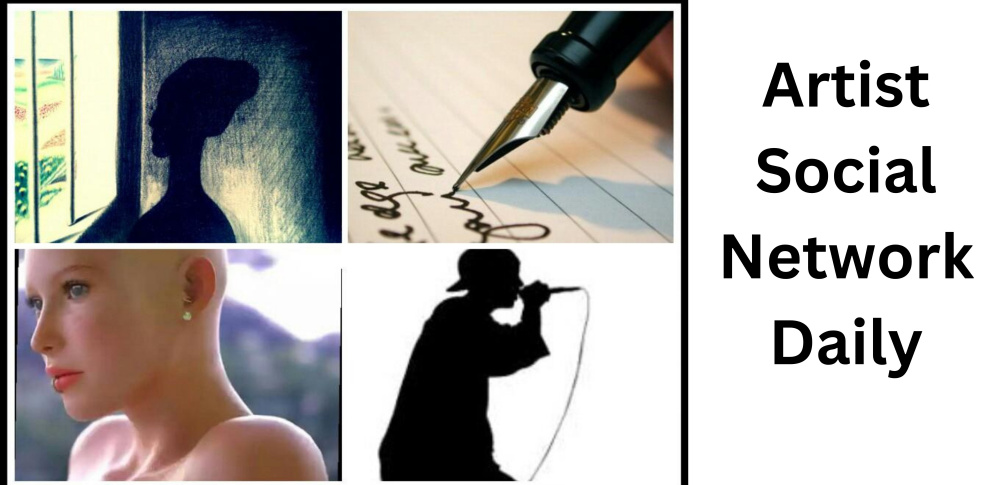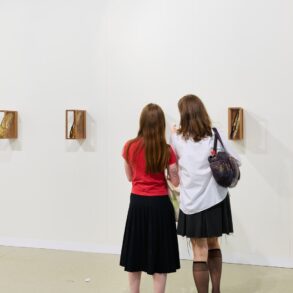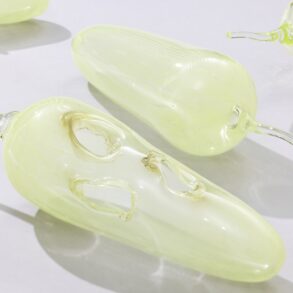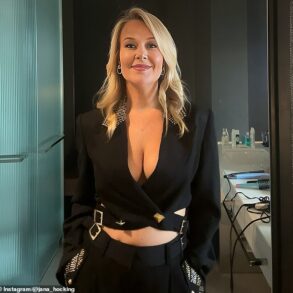Carson House is a place where women come together to talk about various topics, take part in weekly life drawing classes or to see an exhibition of artwork by a local female creative.
Founded by artist Anne Pollard James, Carson House, she says, is “not only for, but mostly for, women. Men are welcome, but it’s a woman’s space.”
On this day, five local female artists are hanging out in the front room. Some know each other well. Others are meeting for the first time. Each of the artists share commonalities, yet their work differs. From oil paintings on canvas to acrylics on woodcut pieces to photography that captures history or utilizes ancient methods to depict the natural world, each woman has their own stories to tell and their own unique methods to do so.
These five artists invited TulsaPeople into their workspaces to show how and why they create the art they do as they discuss how they got where they are today.
Piecing the puzzle together

Ebony Iman Dallas inside her Nomad Mystique workspace at Edison Studios, 4040 W. Edison St., where every second Saturday of the month the resident artists host an open studio with presentations and art available, like Dallas’ gold leaf paintings or works from Somalian artists.
Ebony Iman Dallas arrives at her workspace inside Edison Studios most mornings by 8 a.m. She works alone till around 2 p.m., when she is then joined by her toddler daughter for the rest of the afternoon.
She views all her artwork as puzzles being put together. Dallas is in the early stages of a commissioned fine art piece — her first in a few years.
“It’s basically going to be a big puzzle that some pieces will have acrylic paint, some pieces will have gold leaf and some will have Kenyan textiles,” she says. “All of those will come into the piece that I’m working on.”
She’s recently been focusing more on mural work and creating affordable commercial art pieces, like a small woodcut bird that comes with paint.

“It’s still my art, but you can paint it yourself. You can engage with it in your own way, and it’s relaxing and fun,” Dallas says. “I’m just trying to find ways to make my artwork available to more people.”
Both a fifth-generation Oklahoman and second-generation Somali American born and raised in Oklahoma City, she started out with crayons like most kids and never stopped drawing. By 11 she was taking it seriously, locked in the safe confines of her bedroom drawing Disney characters while dreaming of someday being an animator. It was all cartoons until a high school art teacher told her it was time to do something different. Then it was recreating photos as realistic drawings, which led to painting with acrylics on canvas.
Dallas was raised being told her father died by suicide when her mom was three months pregnant. It was in 2004 through a chance encounter in an Oakland, California, night club when the 23-year-old Dallas was reconnected with her late father’s family still living in Somalia. Conversations with one of her father’s friends led her to investigate his death, and she learned that her dad had been killed by police. Reconnecting with her dad’s side of the family changed her life as her artwork became more and more influenced by African history and culture. Around 2007, her artwork evolved as she started using shapes and colors to create portraits.

Long-inspired by a wood carved mask that was the lone gift from her father to her mother, Dallas’ artwork started incorporating wood cuttings in 2019 after a friend gifted her a scroll saw, then she started using a laser cutter as well. She’s learning how to use a CNC machine, which involves computer programming, for her newest piece.
Dallas’ work has been seen in her joint exhibition with Guggenheim Fellow Ron Tarver at Oklahoma Contemporary, The Romare Bearden Centennial Celebration in New York City and her solo exhibition “Through Abahay’s Eyes” at Oklahoma City’s Literari Press before it was shown at Joyce Gordon Gallery in Oakland. She was a participating artist in The City of Tulsa’s Greenwood Art Project and moved to Tulsa in 2022 after a brief stint here in 2019. In 2023 she was named Paseo Artist of the Year and became a founding fellow of the Oklahoma City Thunder Artist Group.
Fifteen years ago Dallas founded Afrikanation Artists Organization in Hargeisa, Somaliland — which provides art classes and art supplies for kids and art supplies for professionals — and for a year operated a gallery there as well that she credits with sparking more interest in creating art.

Dallas made annual trips to deliver art supplies and visit with the artists until the COVID-19 pandemic halted global travel. She returned in 2024 with her then-6-month-old daughter, who had the opportunity to cuddle with her great grandmother.
Hanging on her studio walls are her paintings along with some created by Somali artists that are for sale. The artists decided one half of sale proceeds go to the artist, while the other half goes to art supplies that are shipped over since they are much more difficult to obtain in the post-war region.
“They’re beautiful pieces, and they need to be shared with the world,” she says.
More information at ebonyimandallas.com.
‘Like a blueprint’

Rector in her dining room as she creates a collage that includes prairie grasses.
Rachel Rector is sitting on her home’s dining room floor as she assembles a collage of different materials that will soon become a cyanotype print on fabric, which she says “combines a historical process from 1842 to contemporary modern processes to make it less traditional and more contemporary.”
For more than a decade, the lifelong photographer has been doing what she calls her “prairie project” based on her infatuation with the natural world that’s surrounded her while growing up in Kansas, Missouri and Oklahoma. She spends time in nature making images on a toy camera and collecting blades of grass to incorporate into her work.

This 25-inch-by-25-inch tapestry collage includes pickings of native plants like prairie grasses sideoats grama, little blue stem and big blue stem. There’s also some poetry she’s written and a large film negative of a prairie scene she captured.
“It’s like a blueprint, where whatever I’m putting on top of the image, once I sandwich it in with either glass or, in this case, acrylic, it will then be put into the sun and developed. It essentially paints the image,” Rector says. “What I then remove — the negative — will be turned into a positive. So each little plant I put down, once it’s removed will become white after its contact with the sunlight. Then once you rinse it in water it becomes a new image and archival.”

She loves this style of art known as an alternative process and often teaches it in workshops for kids, like one she will host this summer in the Kendall Whittier District at Mixed-Use Space Tulsa.
“What that means is basically a lot of the early historical photography practices (used) the sunlight to develop (an image) or plant matter,” she says. “It’s just timeless, and I never tire of it.”
Rector creates cyanotype shirts, necklaces and art pieces, including various sized tapestries that she sells at local markets.

“It is fun to have people own something that’s one of a kind. It could be the same photo, but none of these will ever be exactly the same, and that’s special to me,” says the 34-year-old.
She has spent the past 10 years experimenting in various ways, and after creating a 20-foot tree, she has started contemplating bigger projects.
“I want to do more large-scale fabric cyanotypes of native trees in Oklahoma,” Rector says. “I want to do living trees in the summer. I see just a whole room full of these floating on front and back portions.”

One of Rachel Rector’s cyanotype prints hangs in her home.
Having been raised with a camera in hand and access to a dark room, Rector continues to experiment with film. She is continuing to print photographs on native stones like limestone and sandstone, and she’s been working a lot with moss. She’s also experimenting with printing in the dark room with a projector using a liquid emulsion to print on canvas and then using one of her film photos to project on to the image. A new obsession is making stop-motion animation with 8-millimeter and 16-millimeter film.
“I have some other projects in mind, but I don’t want to share them yet because I haven’t started them,” Rector says. “I feel like that would stop my motivation.”
More information at rachelrector.com.
‘Word Play’

May Yang in her home studio.
It’s mid-January and May Yang is inside her home studio painting what she believes will be the final pieces for her artwork that will be exhibited at Liggett Studios in February as part of her show “Word Play.”
The pieces are what she calls three-dimensional relief paintings comprised of layers of wood that create a collage. There are vibrant colors swirling around and soon “little pieces of letters will get shrunk in or blown up or cut up and reassembled, and that’s kind of how the basis of these come together,” she says.
Growing up as a first-generation Asian American in Tulsa, Yang says she encountered cultural contrasts and communication barriers within her own family, further amplified by language differences — her dad immigrated to the U.S. from Taiwan and her mom from Cambodia.
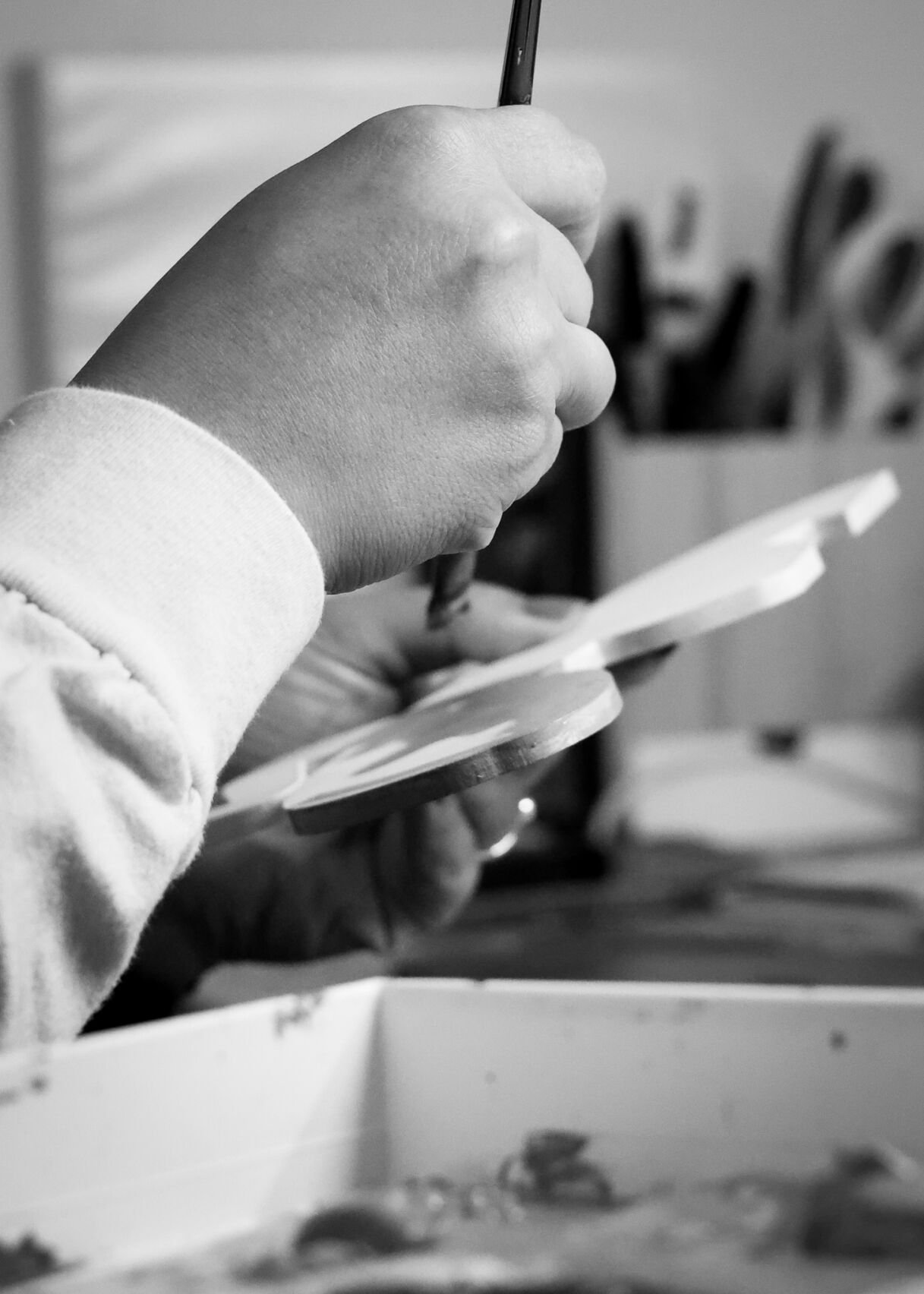
“Mandarin was kind of like the language that they commonly spoke, and they weren’t really fluent in English. So (the pieces were) born from miscommunication. And I think that’s kind of where this tie to these words that aren’t really words, or like English that isn’t really English, kind of comes from.”
Yang grew up an artist and by the time she was a teenager, she tried out screen printing for the first time.
“I got a screen-printing kit from Hobby Lobby and kind of destroyed my parents’ bathroom trying to figure out how that worked on my own,” she says. “I never really quite got to the point where I was making great screens until I had the correct equipment and the correct materials.

Artwork by May Yang hangs on her home studio walls.
“Screen printing is always going to be my first love, but I really gravitated toward lithography too, which is a completely different beast, like a much more complex printmaking method and a little bit more masochistic.”
Yang graduated from Holland Hall in 2004 and thought she would become a graphic designer, so she attended Maryland Institute College of Art in Baltimore, where she fell more in love with printmaking. Then there was a stint at Tamarind Institute at the University of New Mexico before she returned home in 2010. Two years later the then-25-year-old started Flash Flood Print Studios, a screen-printing and design company located in the Kendall Whittier neighborhood.
About a decade ago she dabbled with making collages, but mostly her artistic pursuits took a back seat to business dealings until the COVID-19 pandemic gave her free time and a need to mentally check out.

“I was making little daily sketches in my sketchbook, and like something clicked, and then that’s kind of where I fell back into a more regular art practice,” she says.
Her current project started as sketches using ProCreate on her iPad. From there they became paintings. Then came the idea to layer them with wood-cut pieces.
“This project that is supported by Artists Creative Fund is essentially a way for me to learn machine-assisted construction using materials and equipment from Fab Lab, which is a great place, and then also a way for me to kind of think more dimensionally about the pieces I create,” Yang says. “So the work in itself, like compositionally and the colors, is very indicative of my previous work, but more dimensional. I call them relief paintings.”

Working in her home studio when she can get away from Flash Flood, Yang devotes about two days a week to her art, but as she gets closer to the exhibition opening, she spends more hours in her studio space creating her “bold and colorful abstract art.”
“I know deep down I love process,” Yang says. “I don’t think I would ever have been so drawn to print making if that wasn’t a core part of why I make art. There’s something in my brain that just is really excited about doing all of that and learning all of this stuff.”
More information at mayyang.com.
Learning while working

Cherokee photographer Brittany Bendabout at home.
It started with a Polaroid camera that her great-grandmother owned. The problem was the film was too expensive. Then on her 15th birthday Brittany Bendabout (Cherokee Nation/Otoe) received a Kodak point-and-shoot digital camera from her mom and grandmother.
Growing up in Claremore near its lake, she says her backyard backed up to an open, giant field.
“Me and my friends, we would just hop the fence, and I would take my camera, and we would do photo shoots of each other in this empty field,” Bendabout says. “That’s just really where it started.”
Nobody in the household was artsy, she says. She was shy and quiet growing up, yet she found comfort in capturing candid moments of strangers and became a Claremore street photographer.
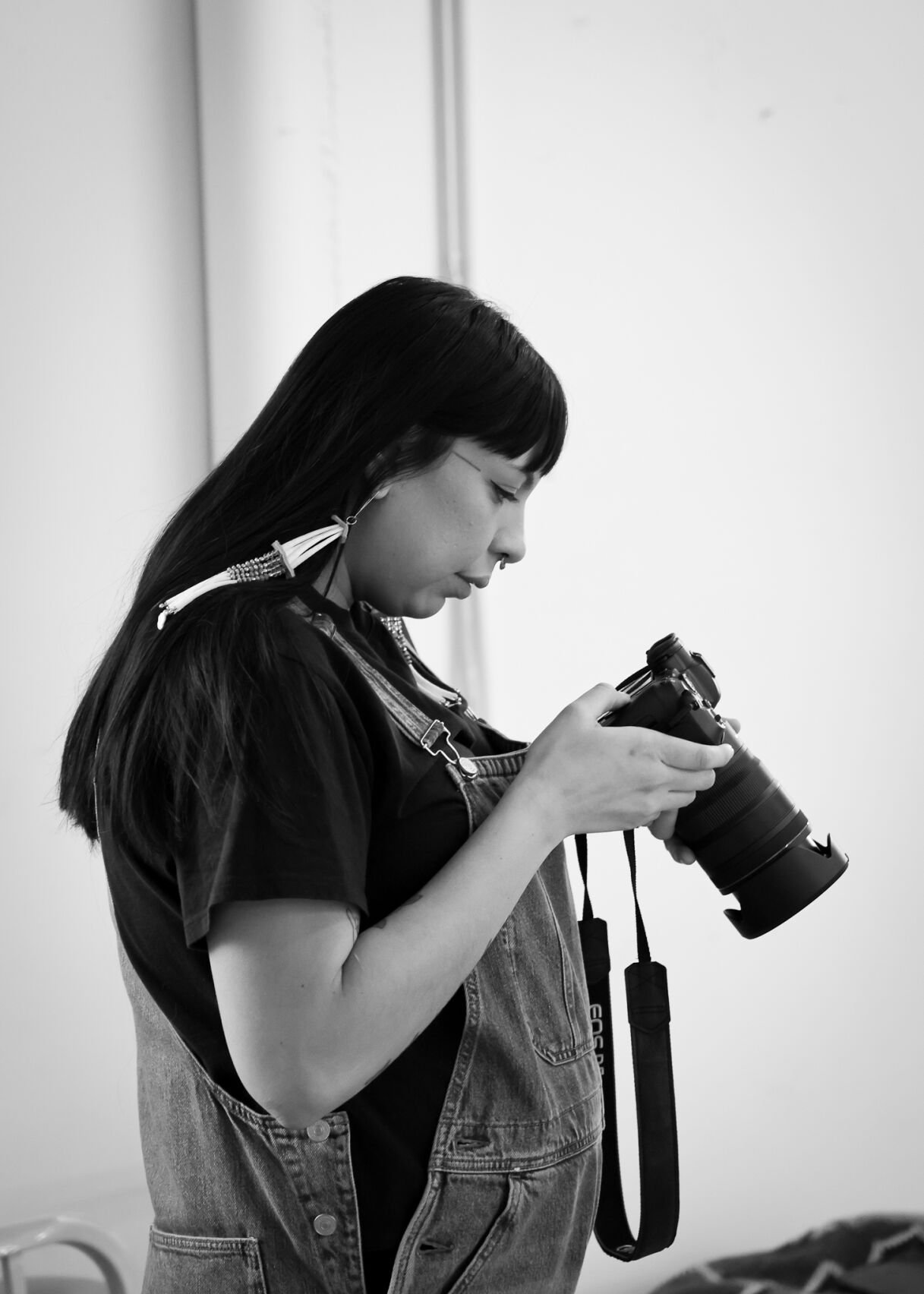
“I could just watch people and observe them and take photos. I would just walk around and probably be a little creepy,” she says as she laughs. “I would just take photos of people at Claremore Lake and whatnot.”
There was a phase where she liked to peruse Claremore’s antique shops and snap pictures of creepy dolls and other antiques that she posted to her Myspace page. It was all just for fun.
She was two years into attending Rogers State University as a business major when Bendabout befriended photography artist Anh-Thuy Nguyen, who was then teaching art at the school. She admired and looked up to the artist, which inspired her to move forward with her photography work and take it more seriously. She graduated with a business degree that was partially funded through her work doing senior portraits and other commissions.

Bendabout at a photo shoot inside Studio Tulsa.
About five years ago Bendabout moved to Tulsa and one of her new first friends was filmmaker Sterlin Harjo, who gave her an opportunity to work in the camera department for “Reservation Dogs.” On set she befriended more creative Natives, which fueled her passion to do more Native photography.
Having always been told she was easy to work with and good at getting people to loosen up during photo shoots, Bendabout decided she would make portraits of elders and try to learn from them while doing it.
“I was always just kind of searching for an elder or somebody to like pour into me, someone I could look up to,” she says.
Two years ago, while on assignment for NPR documenting former students of Riverside Indian School in Anadarko, Oklahoma, Bendabout had one of those moments she had been manifesting.
“There’s this older woman that I took photos of and she just opened up about her time,” she says. “It’s just really cool to sit in somebody’s house and get to do this for work, but also getting something I missed out on as a child, like getting to have conversations and sit down with your elders and learn from them.”
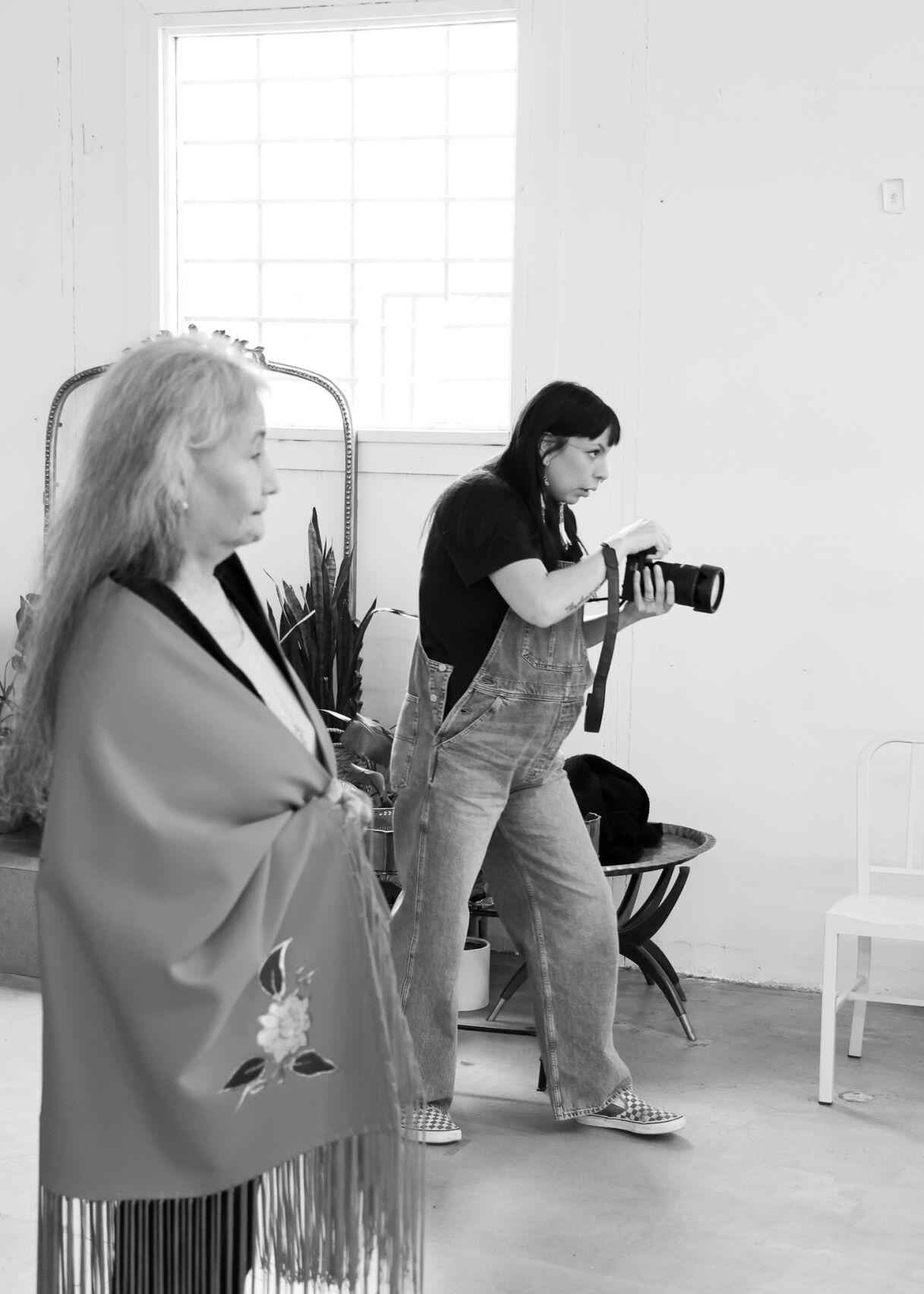
Then came more freelance photojournalism assignments and the opportunity to make portraits for Cherokee Nation citizen Rebecca Nagle’s critically acclaimed 2024 book “By the Fire We Carry: The Generations-Long Fight for Justice on Native Land.”
Bendabout’s current photojournalism series, “The Matriarchs That Made Us,” examines “matrilineal societies in Native America by focusing on matriarchal kinship and its centrality to indigenous beings.” Historically, Cherokees lived in a matrilineal society, so it’s something that runs deep in Cherokee culture. For Bendabout it’s work that has become even more personal as she nears an upcoming due date to welcome her first child.

“Sarah (Chita) Lonewolf, Kiowa,” a portrait Bendabout made for her ongoing “The Matriarchs that Made Us” series.
“I’m stepping into that whole matriarch role, and I think I was kind of waiting on that for this project, which is, like, all right, what does it mean to be a matriarch?” she says. “Now I have to take this a lot more serious. This is a lot more impactful now in my life.”
She’s ready to learn.
More information at brittanybendabout.com.
‘Coming up for air’

Anne Pollard James works on “Sun Drunk” in her studio.
Anne Pollard James likes to paint early in the morning when the natural light has just started illuminating her workspace for the day. Typically, her paintings don’t get a name until she’s finished, but the one she’s working on now is known as “Sun Drunk.” It’s inspired by a model in a vintage magazine advertisement from the 1960s and is her first attempt to do a larger-than-life woman.
“I started working big in 2024. I got my first commission (to do a peony) of a size that I had never done before, and it propelled me to do something that I probably would not have considered on my own then. It changed everything,” says the 52-year-old, who had never picked up a paint brush until 2018, when she was looking for a new creative outlet after taking a drawing class. “(‘Sun Drunk’) is on a 48-by-60, and I’ve had it and two other canvases ready to paint, but for whatever reason, I wasn’t jumping in. Then the moment I finished that giant commission (of the flower), I was like, ‘Oh, I can do this!’”

Working out of her studio just south of downtown, Pollard James continues her ongoing “Coming Up For Air” series, which was the focus of her debut exhibition at Positive Space Tulsa in September 2022.
Her non-commission oil paintings are always about female empowerment. A print of her painting “Boy Tears” hanging in the women’s restroom at bistro Bird and Bottle is a popular backdrop for selfies that are shared on social media.

“I have things that I want to say,” Pollard James says. “There is something about aging and feeling like I give no shits about anyone else’s opinion about what I’m doing in terms of my art, and what I’m thinking and how I want to show my feminist art. That’s something I don’t know that I could have done as a 25-year-old that hadn’t found my voice … At 50 really is when I feel like I started finding it. I didn’t have anything to prove. It was what I wanted to show. I think I aged into it, frankly, and I listened to it.”
Many of her paintings feature scenes of women floating under water, their head unseen above the surface. She says there’s something unexplainable about the way the blue and green phthalo colors she uses for her water depictions hits her psyche. These paintings started when she was transitioning from being a full-time real estate broker to a full-time artist.
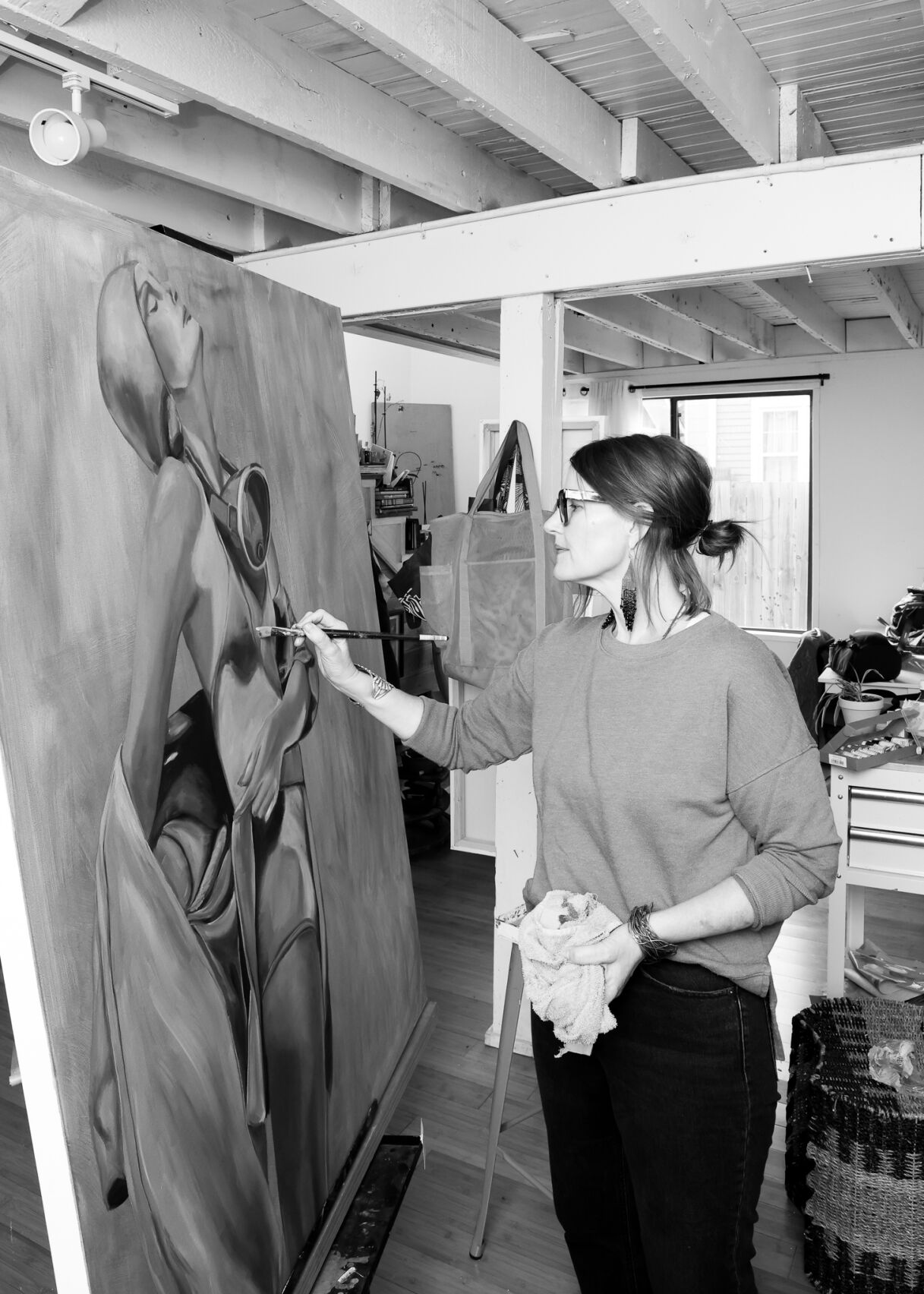
“They’re all part of coming up for air, because it felt like I knew immediately that I just had made this right decision, that there was no question, that there was before and there was after, and this is it, and I’m going,” she says. “I felt like I could breathe for the first f**king time in my life.”
Her artwork is featured on the label of Tulsa-based spirit producer Beach Ball, and her painting “Pretty Mouth” is the cover art for the book “This Strange Garment” by New York-based author Nicole Callihan. Her painting “The Delight Project/No. 5” is included in a National Association of Women Artists group show at Vanda Gallery in New Rochelle, New York.

She hosts weekly life drawing sessions, workshops and exhibitions at Carson House, a workspace she owns that has a focus on supporting women and fostering creativity. She also teaches art at Bishop Kelley High School, where she says “I get to see kids who maybe don’t always feel seen and show them, by kind of my example, that you never have to be finished. You can start over at any moment.”
More information at annepollardjames.com.
This post was originally published on this site be sure to check out more of their content
